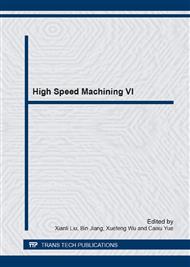p.548
p.553
p.559
p.564
p.571
p.576
p.580
p.585
p.590
Experiment Study of Serrated Chip and Surface Roughness of High Speed Cutting of Ti6Al4V
Abstract:
Under the condition of cutting speed 10-300m/min, rake angle -10°、0°、10°and cutting depths 0.05mm、0.1mm and 0.2mm, the experiment study of adiabatic shear serrated chip and surface roughness are carried out. The influence of cutting condition on serrated chip is analyzed through the metallographic observation of obtained chip. By the measurement of finished surface, the influenc of cutting condition and adiabatic shear on surface roughness is also investigated. The rusults show that the reason lead to serrated chip in high speed cutting of Ti6Al4V is adiabatic shear, not the periodic fracture.The adiabatic shear serrated chip is easier appear and the degree of segment is more large under the condition of higher cutting speed, larger cutting depth and smaller rake angle. The surface roughness is smaller when the cutting speed is higher, cutting depth is larger, and rake angle is smaller.
Info:
Periodical:
Pages:
571-575
Citation:
Online since:
July 2014
Authors:
Keywords:
Price:
Сopyright:
© 2014 Trans Tech Publications Ltd. All Rights Reserved
Share:
Citation:


